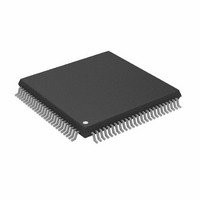ADSP-2189MBSTZ-266 Analog Devices Inc, ADSP-2189MBSTZ-266 Datasheet - Page 13

ADSP-2189MBSTZ-266
Manufacturer Part Number
ADSP-2189MBSTZ-266
Description
IC,DSP,16-BIT,CMOS,QFP,100PIN,PLASTIC
Manufacturer
Analog Devices Inc
Series
ADSP-21xxr
Type
Fixed Pointr
Datasheet
1.ADSP-2189MBSTZ-266.pdf
(32 pages)
Specifications of ADSP-2189MBSTZ-266
Interface
Host Interface, Serial Port
Clock Rate
66MHz
Non-volatile Memory
External
On-chip Ram
192kB
Voltage - I/o
3.30V
Voltage - Core
2.50V
Operating Temperature
-40°C ~ 85°C
Mounting Type
Surface Mount
Package / Case
100-LQFP
Device Core Size
16b
Format
Fixed Point
Clock Freq (max)
66MHz
Mips
66
Device Input Clock Speed
66MHz
Ram Size
192KB
Operating Supply Voltage (typ)
2.5/3.3V
Operating Supply Voltage (min)
2.25V
Operating Supply Voltage (max)
2.75/3.6V
Operating Temp Range
-40C to 85C
Operating Temperature Classification
Industrial
Mounting
Surface Mount
Pin Count
100
Package Type
LQFP
Lead Free Status / RoHS Status
Lead free / RoHS Compliant
Lead Free Status / RoHS Status
Lead free / RoHS Compliant
Other names
ADSP-2189MBSTZ266
Available stocks
Company
Part Number
Manufacturer
Quantity
Price
Company:
Part Number:
ADSP-2189MBSTZ-266
Manufacturer:
MICROCHIP
Quantity:
16 700
Company:
Part Number:
ADSP-2189MBSTZ-266
Manufacturer:
AD
Quantity:
5 510
Company:
Part Number:
ADSP-2189MBSTZ-266
Manufacturer:
Analog Devices Inc
Quantity:
10 000
The ICE-Port interface consists of the following ADSP-2189M
pins: EBR, EINT, EE, EBG, ECLK, ERESET, ELIN, EMS,
and ELOUT.
These ADSP-2189M pins must be connected only to the EZ-
ICE connector in the target system. These pins have no function
except during emulation, and do not require pull-up or pull-
down resistors. The traces for these signals between the ADSP-
2189M and the connector must be kept as short as possible, no
longer than three inches.
The following pins are also used by the EZ-ICE: BR, BG,
RESET, and GND.
The EZ-ICE uses the EE (emulator enable) signal to take con-
trol of the ADSP-2189M in the target system. This causes the
processor to use its ERESET, EBR, and EBG pins instead of
the RESET, BR, and BG pins. The BG output is three-stated.
These signals do not need to be jumper-isolated in your system.
The EZ-ICE connects to your target system via a ribbon cable
and a 14-pin female plug. The female plug is plugged onto the
14-pin connector (a pin strip header) on the target board.
Target Board Connector for EZ-ICE Probe
The EZ-ICE connector (a standard pin strip header) is shown in
Figure 13. You must add this connector to your target board
design if you intend to use the EZ-ICE. Be sure to allow enough
room in your system to fit the EZ-ICE probe onto the 14-pin
connector.
The 14-pin, 2-row pin strip header is keyed at the Pin 7 loca-
tion—you must remove Pin 7 from the header. The pins must
be 0.025 inch square and at least 0.20 inch in length. Pin spac-
ing should be 0.1 × 0.1 inches. The pin strip header must have
at least 0.15 inch clearance on all sides to accept the EZ-ICE
probe plug.
Pin strip headers are available from vendors such as 3M,
McKenzie, and Samtec.
REV. A
Figure 13. Target Board Connector for EZ-ICE
KEY (NO PIN)
RESET
ELOUT
GND
EBG
EBR
EE
13
11
1
5
7
3
9
TOP VIEW
10
12
14
2
4
6
8
BG
EINT
ELIN
BR
EMS
ERESET
ECLK
–13–
Target Memory Interface
For your target system to be compatible with the EZ-ICE emu-
lator, it must comply with the memory interface guidelines listed
below.
PM, DM, BM, IOM, and CM
Design your Program Memory (PM), Data Memory (DM),
Byte Memory (BM), I/O Memory (IOM), and Composite
Memory (CM) external interfaces to comply with worst case
device timing requirements and switching characteristics as
specified in this data sheet. The performance of the EZ-ICE
may approach published worst case specification for some memory
access timing requirements and switching characteristics.
Note: If your target does not meet the worst case chip specifica-
tion for memory access parameters, you may not be able to
emulate your circuitry at the desired CLKIN frequency. De-
pending on the severity of the specification violation, you may
have trouble manufacturing your system as DSP components
statistically vary in switching characteristic and timing require-
ments within published limits.
Restriction: All memory strobe signals on the ADSP-2189M
(RD, WR, PMS, DMS, BMS, CMS, and IOMS) used in your
target system must have 10 kΩ pull-up resistors connected when
the EZ-ICE is being used. The pull-up resistors are necessary
because there are no internal pull-ups to guarantee their state
during prolonged three-state conditions resulting from typical
EZ-ICE debugging sessions. These resistors may be removed at
your option when the EZ-ICE is not being used.
Target System Interface Signals
When the EZ-ICE board is installed, the performance on some
system signals change. Design your system to be compatible
with the following system interface signal changes introduced by
the EZ-ICE board:
• EZ-ICE emulation introduces an 8 ns propagation delay
• EZ-ICE emulation introduces an 8 ns propagation delay
• EZ-ICE emulation ignores RESET and BR when single-
• EZ-ICE emulation ignores RESET and BR when in Emula-
• EZ-ICE emulation ignores the state of target BR in certain
between your target circuitry and the DSP on the RESET
signal.
between your target circuitry and the DSP on the BR signal.
stepping.
tor Space (DSP halted).
modes. As a result, the target system may take control of the
DSP’s external memory bus only if bus grant (BG) is as-
serted by the EZ-ICE board’s DSP.
ADSP-2189M













